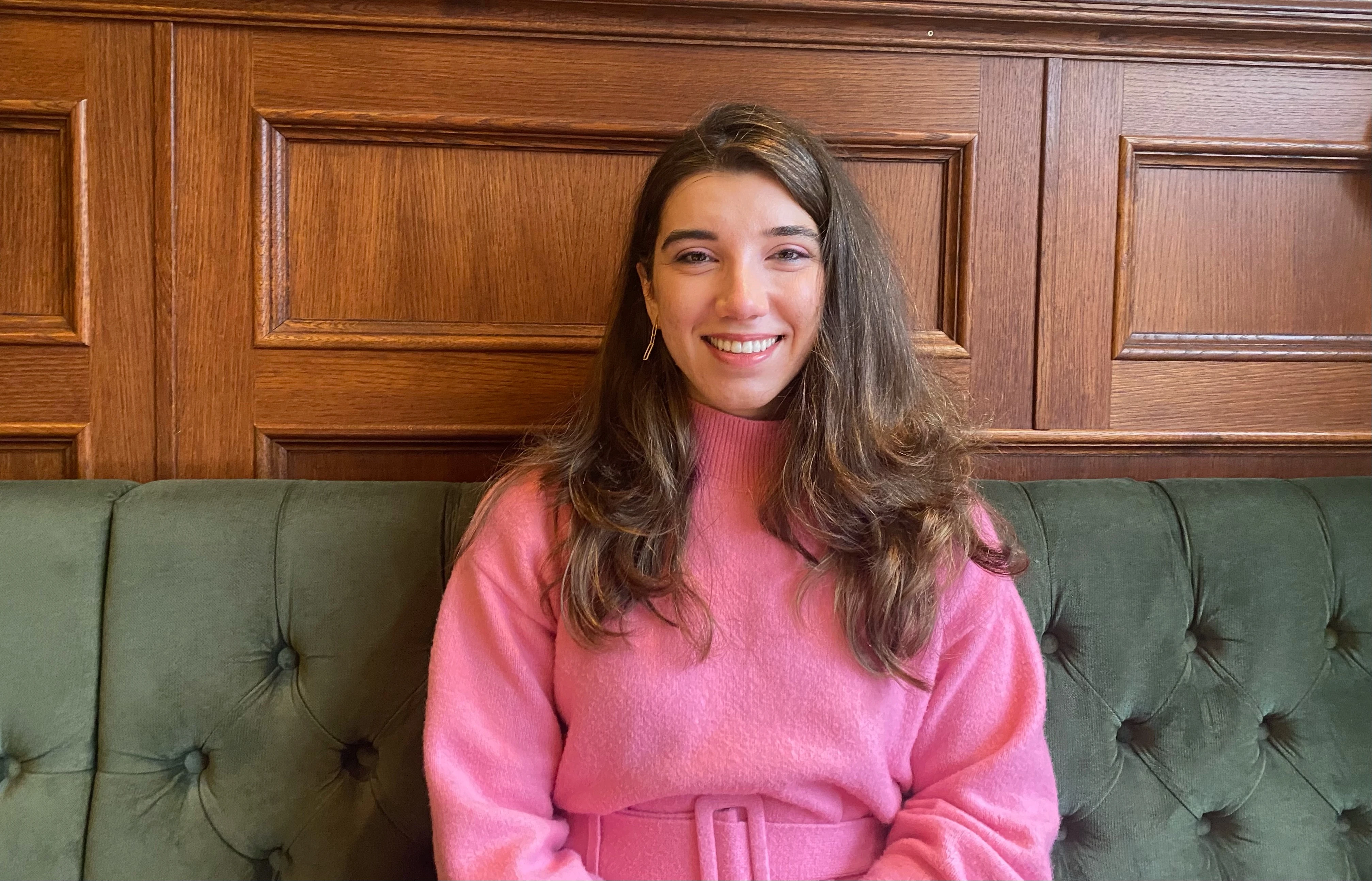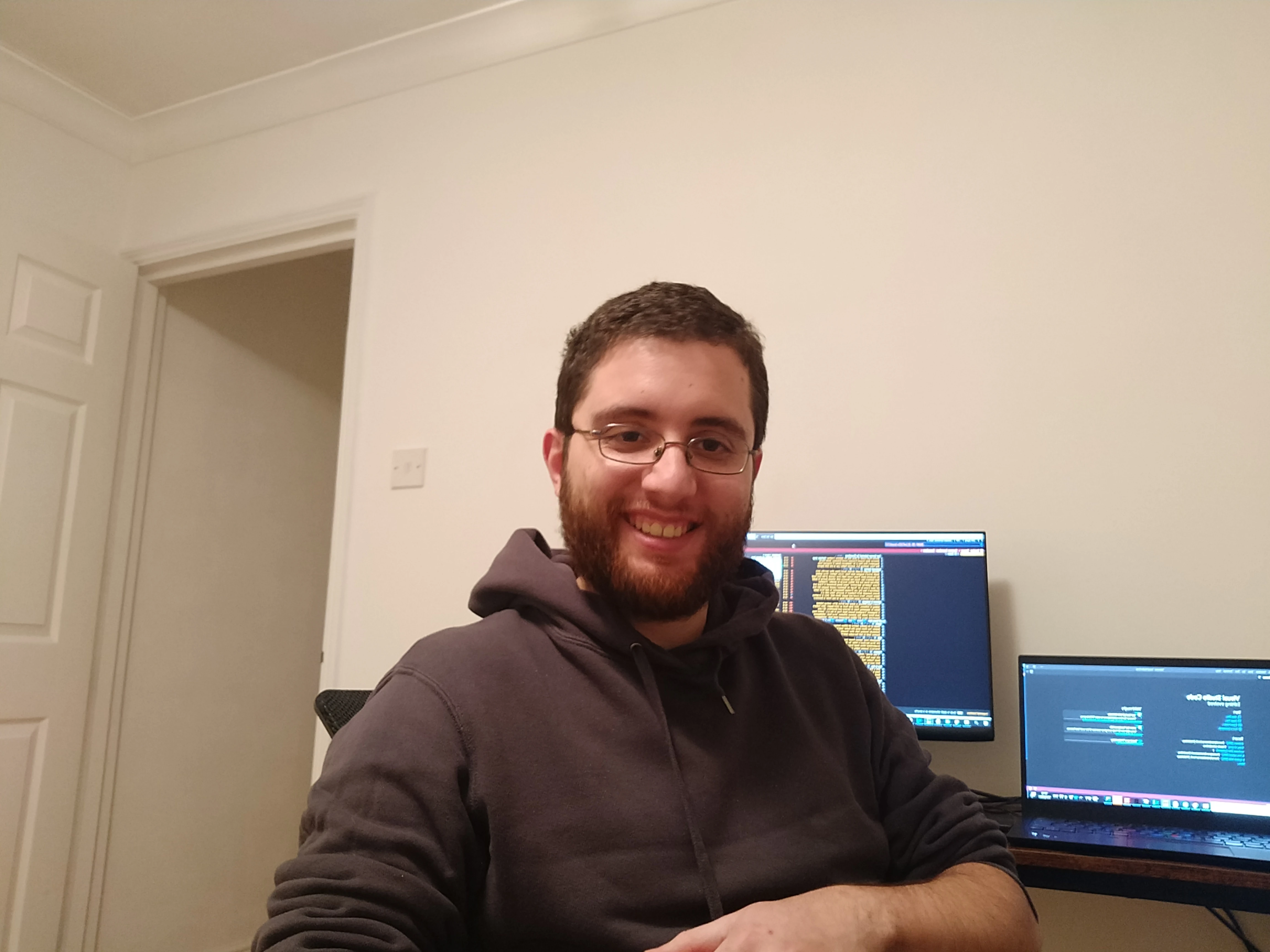Meet the Team: Research Collaboration & Analytics Engineering
January 20, 2022
The Research Collaboration & Analytics Engineering team in London is part of the Equity Research group, which is part of the larger Markets, Community & AI (MCA) group in Bloomberg’s Engineering department. Equity Research builds applications that our clients use to analyze market trends, compare and contrast companies, evaluate analyst predictions, and refine investment ideas. For example, a client can see what Wall Street analysts believe the performance of a company will be, build an investment model from thousands of characteristics, and then analyze the historical model performance. These solutions deliver real-time critical insights and alerts based on clients’ current holdings.


First, let’s meet Engineering Manager Richard Labonté, the head of the Research Collaboration & Analytics Engineering team.
Tell us about your role as head of Research Collaboration & Analytics Engineering, and what the team is responsible for.
Our team is part of the broader Equity Research group. We are focused on helping research analysts find the best opportunities in the markets. We provide a full suite of tools to help them research, analyze, and interpret data to help them construct a clear picture of a particular investment opportunity.
More specifically, our group provides enterprise solutions for groups of analysts from the same firm or desk. We help them collaborate better with their peers by offering them tools to aggregate and share their documents via our FILE product. We also provide them with a note-taking product to gather their thoughts and present them to their colleagues via our NOTE product.
For research firms looking to sell their research to other firms, we provide many different ways to get precise and accurate valuations of their research and various interactions with their counterpart. This helps both sides obtain a neutral perspective on how valuable their research has been. To do this, we offer various utilities to capture interactions between firms — and even within firms — to help surface the necessary data for both sides to agree on a price.
We also provide simulated trading tools where analysts can maintain a virtual portfolio where they can sell their investment ideas to others. Finally, we also help them more directly on the research front by helping interpret their search query and find the data they are looking for.
What are some of the unique technical challenges your team needs to tackle?
As part of the Research department, it is really important for us to understand our client’s needs so that we can provide workflows that will boost their productivity. Some of our products, like NOTE or FILE, are used by a varied range of Bloomberg customers, so it’s also important to provide them with generic functionality that caters to their needs.
Briefly tell us about your career path.
I joined Bloomberg as an engineering intern in 2007. I was lucky enough to be offered the opportunity to have a second internship in 2008 and finally got a full-time offer in 2009. I worked out of the New York office for a couple of years before an opportunity opened up in London, and I was offered a transfer, which I gladly accepted. A couple of years down the line I became a team leader and then more recently an engineering manager.
What’s your strategy for choosing team members?
I am always looking for someone who can bring something new to the team. It might be someone who has knowledge about things we don’t already know or someone who simply brings in some new perspectives. I am keen on having people who are proactive, collaborative, and proud to own part of our system.
What skills do you look for when hiring engineers for your teams?
A passion for getting things done, the right way. An ability to design complex large distributed systems. Great communication and collaboration skills.
What are some of the factors driving the rapid growth of your group?
There are a lot of opportunities in the Financial Research field. Bloomberg is well positioned, but we can do more. The company is very focused on this particular market and has invested a lot recently to ensure we are delivering the right tools that are competitive with other solutions in the market.
How do you foster culture on your team?
I always encourage people to seek the opinions of others, as well as to share their own. I also encourage everyone to think about what they’re passionate about and to share this with their team leader to help align their work and their passion.
“We are focused on helping research analysts find the best opportunities in the markets. We provide a full suite of tools to help them research, analyze, and interpret data to help them construct a clear picture of a particular investment opportunity.”
– Richard Labonté


Ivaylo Pavlov is a Software Engineering Team Leader on the Notes team. He’s working on NOTE and its integration across various functions throughout the Terminal.
What is the biggest challenge in your current work?
The biggest challenge is the distributed nature of the system and the fast performance and real-time notifications our clients expect. What excites me is the level of impact our contributions can have on users’ investment decision-making, combined with the cross-team collaboration and technical knowledge required to successfully deliver new features.
What made you decide to learn software engineering, and why apply it to the finance sector?
I was a summer intern in Bloomberg’s Sales & Analytics departments in 2011, which opened the door to a full-time offer to join the company after I graduated. I joined the Analytics department in September 2012 with a focus on Equities, Trading, Technical Analysis, and Portfolios. Despite my finance focus, I always kept my technical knowledge up to date, with more of a data science focus (R, Python, Pandas, NumPy and Charting). I always tried to find a way to leverage my coding knowledge in solving client problems. After almost five years, I decided that I wanted to try to turn my hobby into a full-time job. I interviewed internally in 2016 and successfully joined the Engineering department, which started me on my path toward building scalable and fault-tolerant distributed systems.
What do you feel is an advantage to hiring more people with career experience outside of software engineering and financial analysis?
Having a non-software engineering background definitely adds a different point of view from which the entire group benefits. Everyone comes with their unique life experiences and perceptions of the world. When combining suggestions to arrive at the most optimal solution for a problem, having a variety of ideas is of utmost importance. A different career path is always a positive, as the ability to combine two fields of knowledge is a great advantage.
Bloomberg has a distinctive culture. What attracted you to it?
The level of support and collaboration throughout all my years in the company is definitely unique. I’ve been supported in all aspects of my professional growth, in both fields — finance and software engineering. I’ve received support in every endeavor I’ve asked to participate in, like attending a conference across the world or working on open source projects. Along the way, I’ve created life-long friends with who I still keep in touch on a regular basis.
How do you foster a collaborative, inclusive environment at work?
That’s a good question. Personally, I believe it’s the ability to express yourself freely and not being afraid to pitch ideas, no matter how wild they actually might seem at first glance. This keeps the idea generation spark alive and great ideas spread like wildfire. A safe environment in which to experiment builds trust, which fosters collaboration. Everyone being their genuine self and respecting every team members’ opinion is essential to having an inclusive workplace.
What do you think a team must have to be effective and healthy, particularly during this time of disruption?
The core principles for a team should be trust and support, especially in times of disruption and frequent change. We were able to transition smoothly to working remotely due to the nature of the work that goes into software development. Providing support in difficult times and trusting people to do the right thing are what give people the opportunity to be empowered and productive. Looking after each other and checking in, even if it’s for a virtual coffee, can make a world of difference.
“The level of support and collaboration throughout all my years in the company is definitely unique. I’ve been supported in all aspects of my professional growth, in both fields — finance and software engineering.”
– Ivaylo Pavlov


Adriana Razoare is a recent hire who is rounding out her first year at Bloomberg. She is a Software Engineer in the Content Platform team, working on the Bloomberg Terminal’s FILE product.
What is the biggest challenge in your current work?
Always finding the best solution that meets our product and engineering standards. Finding all the pieces to the puzzle which we are endeavoring to solve, not only when it comes to dependencies on the technology side, but also on aspects relating to the excellent user experience we are offering our clients.
How did you find out about Bloomberg? What made Bloomberg stand out for you? Why did you choose Bloomberg?
Having previously worked on the tech side at two other financial companies gave me the opportunity to gather information about the company’s activities, the quality of its products, and the people who work here. After a discussion about the company’s culture, as well as an insightful discussion with the Recruiting team, I decided to apply. I can confirm that my experience matches my impression from the research I’d previously done, with ample opportunities for me to explore and delve into.
Bloomberg has a distinctive culture. What attracted you to it?
The most crucial point was the collaborative feel that Bloomberg champions. This includes the diversity and inclusion of communities, its philanthropic values, and all the amazing tech groups here. Asking and offering to help is normal behavior here that is very much encouraged.
How does your involvement with Bloomberg’s D&I Communities impact your life? What are some of the activities you’re involved with?
As a relatively new joiner to Bloomberg, I am still discovering our D&I Communities, and I am especially grateful that these communities not only create a safe place for conversation, but also actively help members and take action to escalate and address issues to higher levels within the organization.
I personally believe in the importance of constant education around various diversity and inclusion topics, as there is always something more that can be done. Bloomberg is a great workplace that constantly promotes this.
Since July, I have been a member of WMCAL (Women in MCA London), and I worked alongside two other organizers to create a support network for all our members, helping them advance in their careers and grow their networks; raising awareness of all the resources at hand, including mentorship, technical programs, events and ongoing D&I work; and also collaborating with other D&I initiatives to achieve common goals.
“I personally believe in the importance of constant education around various diversity and inclusion topics, as there is always something more that can be done. Bloomberg is a great workplace that constantly promotes this.”
– Adriana Razoar


Pedro Miguel Candeias Martins joined the Research Collaboration & Analytics Engineering team as a Software Engineer in May 2021. He’s working on a tool called TMSG, which allows customers to create investment ideas, like when to sell or buy stocks, track their performance over time, and share those ideas with other users.
What is the biggest challenge around your current work?
The biggest challenge I have faced so far is the scale of the product. As it needs to model most of the diverse strategies used in real financial systems, it can be daunting at times to try to understand all of its intricacies. But it is extremely satisfying when you do, and to see that you’re creating something that is used by a large number of users.
How did you find out about Bloomberg? What made Bloomberg stand out for you? Why did you choose Bloomberg?
When I began looking for internships during my studies, I learned about Bloomberg and thought it looked interesting. I attended a Bloomberg event at my college, where I learned more about the company and about the many challenges and opportunities it presented. I joined Bloomberg for the first time that summer as an intern. It was such a great experience that I did additional internships the following two summers and then decided to join full-time at the end of my studies.
Tell us about the mentorship you’re receiving at Bloomberg.
After going through the training program and joining my team, I was paired up with an experienced developer who guided me through the process of joining a team and beginning to make contributions to our code (e.g., learning to use our software development tools, learning about our systems, understanding the workflow within the team, etc.). We hold frequent one-on-one meetings where I’m able to ask more detailed questions. I am also surrounded by people who are experts in many different tools and technologies, and I am encouraged to reach out to them.
“As [our product] needs to model most of the diverse strategies used in real financial systems, it can be daunting at times to try to understand all of its intricacies. But it is extremely satisfying when you do, and to see that you’re creating something that is used by a large number of users.”
– Pedro Miguel Candeias Martins


Di Wu joined Bloomberg seven years ago, and is currently the Team Lead for the newly formed Query Intelligence team.
What is the biggest challenge in your current work?
Our biggest challenge as a team is to improve the overall search experience for research analysts by intelligently interpreting what they type into the search entry. It includes features such as search expansion with synonyms and search interpretation, leveraging our in-house NLP framework. In addition to the problem space being very interesting, we also have the opportunity to collaborate with a group of talented and inspiring people.
What is it like moving to different teams within Bloomberg? How have you adapted?
Internal mobility is highly supported within Bloomberg. The managers in my previous team actively helped me look for new opportunities across the engineering department. With the help of HR and our internal job posting function, I was constantly aware of the current and new openings within the company. Because I was proactively looking to change, I had the time to meet with managers who were hiring and to plan out my transition plan to ensure a smooth handover. As mentioned earlier, I am excited about what we are working on in the new team. It has been an amazing learning experience working with people in my current role.
What advice do you have for people from underrepresented groups who are pursuing a career in tech?
One piece of advice I would give is: we are all unique and remarkable in different ways, and it’s important to find your areas of excellence. Coming from an underrepresented group, you might have the urge to try to fit in or conform. Do not give up on your uniqueness. What makes you different can also be your areas of excellence. Within Bloomberg, we cultivate a diverse and inclusive culture. So don’t hesitate to let your voice be heard.
What are your best tips for inspiring direct reports?
If you are in the early stages of your career, it’s important to say “yes” to opportunities, even if you are uncertain about them. A heavy focus on exploration will be the best way to learn about yourself: what motivates you, what you are passionate about, what your strengths and weaknesses are, etc. Stepping out of one’s comfort zone is hard but very rewarding. After you have a good grasp of your passions and motivators, the ability to prioritize and focus on what truly matters to you becomes much more important. At this stage, you can dial down (but not stop) on exploration. Being able to say “no, thank you” to “okay” projects will reduce distractions and give you more time to work in your areas of excellence.
What else should we have asked you about? What else would you like to share about your Bloomberg experience?
Bloomberg has a relatively flat hierarchy within Engineering, which I personally appreciate. It means that we can customize how we would like to enhance our impact outside of our core responsibilities. For example, some engineers prefer to be the “guru” (becoming domain experts in certain areas), some want to be the “organizer” (focusing on improving team efficiency on top of their day-to-day engineering work), and some want to be the “informationalist” (being aware of technology trends both within and outside the company and sharing information with the team). This level of autonomy and ownership is part of Bloomberg’s culture.
“In addition to the problem space being very interesting, we also have the opportunity to collaborate with a group of talented and inspiring people.”
– Di Wu
Check out some open roles with our Research Collaboration & Analytics Engineering team